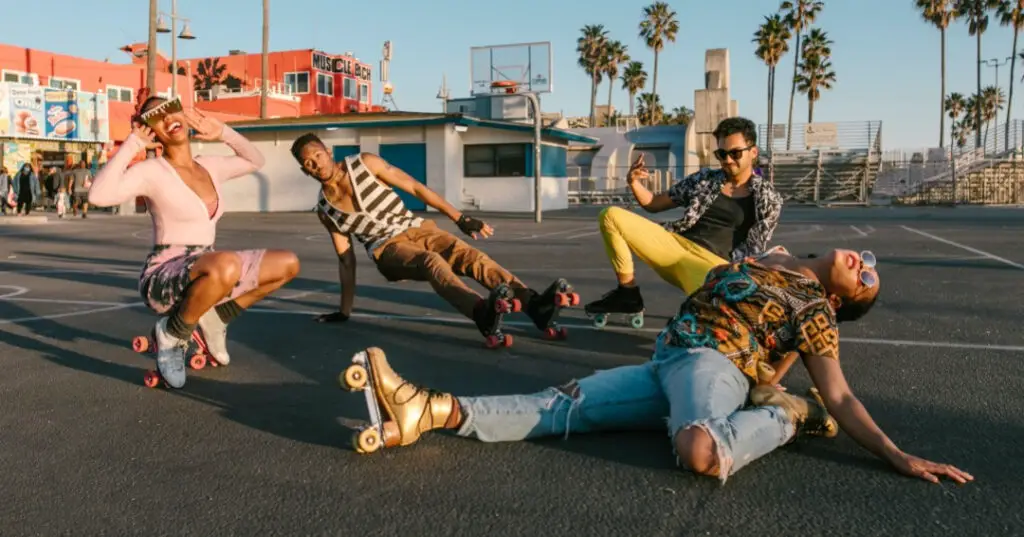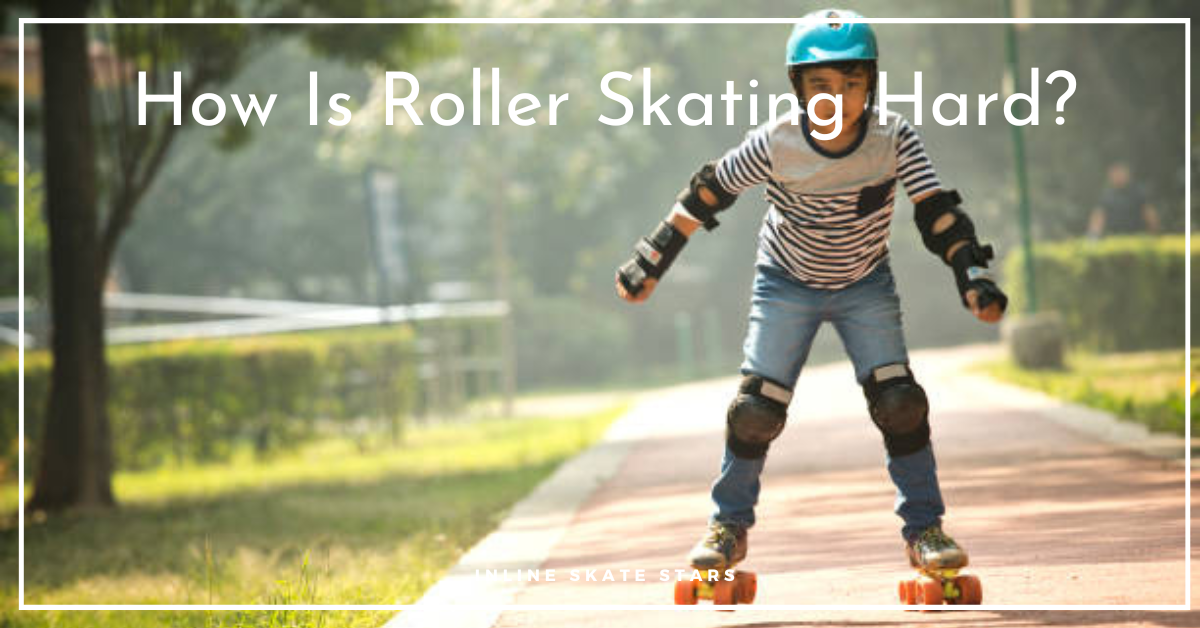How is roller skating hard?
Roller skating is a terrific sport. If you’re struggling with weight, roller skating is your best bet.
Due to its rigor, roller skating engages almost all body muscles. It helps burn calories. Plus, because of the smooth gliding, there is no undue stress applied to your joint.
Roller skating is also a great pastime and a way to get around.
But to enjoy these benefits, you need to surmount a steep learning curve that can be frustrating and demoralizing.
Lack of proper guidance can lead to frustration and even giving up.
Let me hold your hand and help you overcome the hurdles that have stagnated your progress, and you will be gliding like a pro in no time.
Deal? Let’s roll.
How Is Roller Skating Hard?
How is roller skating hard?
Roller skating can be hard since you have to learn and master the appropriate techniques like posture, braking, body balance, the ready position, how to push and glide, and how to fall safely, which can be a hurdle for beginners.
Roller skating can also be hard since you must have the right mindset and find the right places for skating.
Importantly, you need like-minded people to push you and to help you flatten the learning curve.
But this is only the scratch on the surface. Below, we examine each factor in detail!
1. Learning and Mastering the Correct Roller Skating Techniques Can be a Hurdle
Learning and mastering the correct roller skating techniques can be a hurdle. Just like a toddler learning to walk, a teenager learning to ride a bike, learning to roller skate requires patience.
With social media awash with ‘look, I’m cooler than you’ stunts; it’s easy to get carried away watching pros perform spins, backward rolls, crossover turns, and heel-toe steps.
But remember, it takes dedicated practice to build the stamina and master the balance to perform those tricks.
Allow your glute muscles, core muscles, quadriceps muscles, hamstrings muscles, and adductors muscles to develop.
Take time to learn the basic skills you need to begin a roller skating journey. They include:
- The ready position
- Recommended posture
- How to fall safely
- How to push and glide
- Braking
- Body balance
Read on to learn more!
Master the Ready Position
The ready position is your ‘fallback and regroup’ position when roller skating. Here are the checkpoints for a ready position:
- Place your feet parallel, shoulder-width apart.
- Bend your knees and rest your weight on the balls of your feet.
- Bring your shins in contact and support them with the top ankle straps.
Practice on grass as it offers more friction on the skate wheels while providing a soft landing when you fall.
Develop the Correct Roller Skating Posture
Your posture when roller skating influences your balance, and balance is at the core of any skating adventure. This is where the recommended roller skating posture comes in handy.
What is the recommended skating posture?
Squat with your legs shoulder width apart. Lean forward while assuming a comfortable squatting position; heels stacked, toes pointed outwards. Let your weight rest on the balls of your feet. This is the recommended roller skating position.
This position increases your balance by lowering your center of gravity and expanding your base area.
Learn to Balance on Roller Skates
You can’t roller skate if you can’t balance. That’s it. If you try otherwise, you will end up hurt.
To balance on skates, you need three things: a lower center of gravity, a large base area, and flexibility.
A good posture, as discussed above, will help you achieve a lower center of gravity and a large base area and help boost your balance.
Flexibility increases your body’s range of motion and reduces joint stress when you skate.
This fluidity allows you to float naturally in the air and shift your body mass seamlessly to maintain the dynamic balance on the roller skates.
Safe Landing
Always return to the ready position when you start losing balance. Remember, your skate wheels will move according to the law of inertia.
Maintaining a slight forward lean is crucial to avoid falling on your backside — this could hurt your spine.
When falling, lean forward to land on your knees. If necessary, use your hands to avoid toppling over.
Learn to Glide
In a squatting position, heels together, toes pointing outwards, steadily move forward; start to the right, then to the left, then back to the right, and so forth.
As your confidence level rises, take longer steps and give yourself room to roll. Glide with one foot until you lose momentum, keeping the other mid-air.
To make a right turn, lean your body moderately to the right. To make a left turn, lean your body moderately to the left. Maintain a squat position.
Build momentum by increasing the angle of your legs, applying pressure on the wheels, and pushing harder and faster. Use your hands for balance.
Learn to Brake
Braking when roller skating is critical – it gives you control of your voyage and reduces the possibility of a collision.
Manufacturers include a brake on the right roller skate at the skate’s toes. Glide with your skates parallel to apply brakes. Lean forward moderately while squatting.
Move the right skate slightly in front of the left skate. Press on the brakes with your toes. The more force you apply on the brakes, the more abruptly you’ll come to a halt.
2. Keeping the Right Mindset is Challenging

Learning roller skating, just like any new skill, demands your undivided attention. But fear of falling can paralyze your progress in learning to roller skate.
Having a positive mindset will help you overcome this fear. Positive visualization will help you achieve a positive attitude.
Also, surround yourself with roller skating friends who will encourage, challenge, and empower you.
Be sure to follow mentors with good roller skating practices and not just gimmicks to impress. Once formed, bad behaviors are difficult to break. So, learn the right skills from the start.
Always be mindful and aware of your surroundings when roller skating to avoid incidents.
3. Finding the Right Places for Skating can be Daunting
Skating carries an inherent risk of falling, and if you are not well protected or fall the wrong way, you can hurt yourself.
Wear a helmet to shield your head, knee pads to prevent knee bruises, and wrist guards and elbow pads to protect your hands.
Ensure your skates are fitting. They should fit snugly and comfortably. A good gauge is having a finger gap at the heel when the toes touch the front of the skate. Lace them properly.
Roller skate in an open space without obstacles. You run a higher risk of injury when roller skating in a crowded place.
Identify a skating rink or a level ground, free of barriers to practice on. Practice at least once a week to master the skills quickly. Having a skating routine ensures you allocate time for practice.
Try these roller skating surfaces as your skills improve, and your confidence grows.
4. Teaming up with like-minded Skaters is Tasking for Introverts
Skating is fun. Skating with friends is even more fun. But teaming up with like-minded skaters can be daunting, especially for introverts.
Having a team to practice with, share dreams and experiences – and just have fun together goes a long way.
In a team, you will be challenged, receive peer advice, and have excellent accountability partners.
How is Roller Skating Hard? | Wrapping Up
Roller skating has a steep learning curve that can be a nightmare to crack. Without proper guidance, a newbie will likely go in circles and despair.
This can lock you out of the numerous benefits roller skating provides. The pathway provided above, combined with dedicated practice, will have you cruising in no time.
But remember: Practice does not make perfect; perfect practice makes perfect – Vince Lombardi.
See you at the roller skating rinks!



